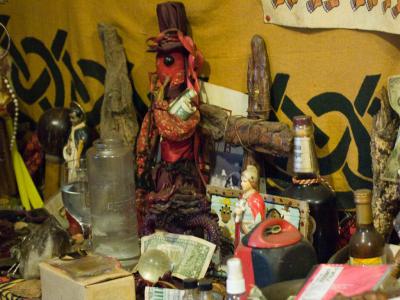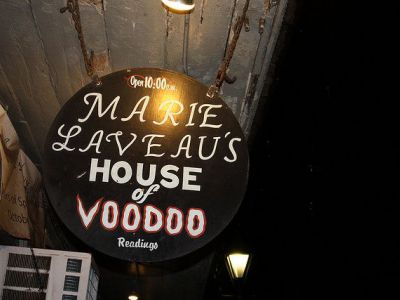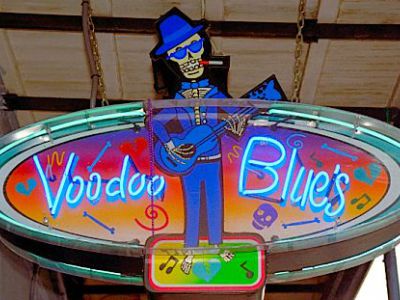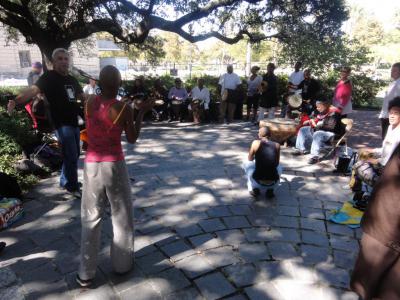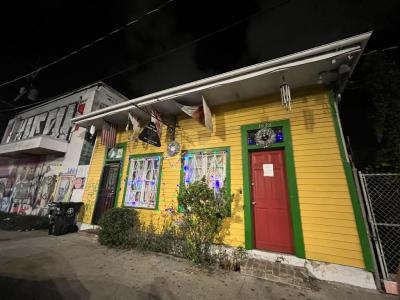
Voodoo Tour (Self Guided), New Orleans
Voodoo is an ancient ritualistic practice brought by enslaved West Africans onto the American soil upon their arrival in the 18th century. This form of religion was most prominent in New Orleans from the 1820s through the 1860s, when it was introduced by the “Voodoo Queens”. Of these, Marie Laveau became more prominent as she overthrew other queens to become the sole oracle.
Your best introduction to the still surviving culture would be Voodoo Authentica, which, albeit small, houses a variety of interesting objects, such as an impressive collection of African masks. The staff is very accommodating, but the best part is that they’re all Voodoo practitioners who can give the straight scoop. If seeking a ‘spiritual cleansing’ or reading, definitely stop by.
Another good jumping-off point to learn about many curious practices, the Historic Voodoo Museum is full of history and character, charms and chants, standing close to “Voodoo Queen” Marie Laveau’s own house just around the corner.
Further along the road, Reverend Zombie's House of Voodoo is a great spot for non-practitioners, who will appreciate that items are explained with ample description/signage, and prices are clearly marked. The proprietor is very well-informed and helpful, if you ask specific questions and truly have an interest in the religion.
To learn more about Voodoo and expand on the fascinating history of New Orleans, take this self-guided walking tour!
Your best introduction to the still surviving culture would be Voodoo Authentica, which, albeit small, houses a variety of interesting objects, such as an impressive collection of African masks. The staff is very accommodating, but the best part is that they’re all Voodoo practitioners who can give the straight scoop. If seeking a ‘spiritual cleansing’ or reading, definitely stop by.
Another good jumping-off point to learn about many curious practices, the Historic Voodoo Museum is full of history and character, charms and chants, standing close to “Voodoo Queen” Marie Laveau’s own house just around the corner.
Further along the road, Reverend Zombie's House of Voodoo is a great spot for non-practitioners, who will appreciate that items are explained with ample description/signage, and prices are clearly marked. The proprietor is very well-informed and helpful, if you ask specific questions and truly have an interest in the religion.
To learn more about Voodoo and expand on the fascinating history of New Orleans, take this self-guided walking tour!
How it works: Download the app "GPSmyCity: Walks in 1K+ Cities" from Apple App Store or Google Play Store to your mobile phone or tablet. The app turns your mobile device into a personal tour guide and its built-in GPS navigation functions guide you from one tour stop to next. The app works offline, so no data plan is needed when traveling abroad.
Voodoo Tour Map
Guide Name: Voodoo Tour
Guide Location: USA » New Orleans (See other walking tours in New Orleans)
Guide Type: Self-guided Walking Tour (Sightseeing)
# of Attractions: 8
Tour Duration: 2 Hour(s)
Travel Distance: 2.6 Km or 1.6 Miles
Author: ann
Sight(s) Featured in This Guide:
Guide Location: USA » New Orleans (See other walking tours in New Orleans)
Guide Type: Self-guided Walking Tour (Sightseeing)
# of Attractions: 8
Tour Duration: 2 Hour(s)
Travel Distance: 2.6 Km or 1.6 Miles
Author: ann
Sight(s) Featured in This Guide:
- Voodoo Authentica
- Historic Voodoo Museum
- Marie Laveau's House of Voodoo
- Voodoo Blues
- Reverend Zombie's House of Voodoo
- St. Louis Cemetery No. 1
- Congo Square
- Voodoo Spiritual Temple
1) Voodoo Authentica
Located on peaceful Dumaine Street in the historic French Quarter of New Orleans, Voodoo Authentica has been owned and run by Voodoo practitioners since 1996. It's more than just a shop; it's also a temple, a cultural hub, and a space for learning about Voodoo. Here, experienced Voodoo experts perform rituals, offer spell readings, conduct spiritual work, and provide consultations.
Inside the shop, you'll discover a wide range of locally crafted Voodoo items, including handmade Voodoo dolls, gris gris bags, potent oils, candles, incense, and an assortment of unique traditional items associated with New Orleans, Haitian, or African Voodoo traditions. You can even come across unique jewelry pieces like necklaces made from alligator claws and teeth. Every individual working here practices Voodoo, and almost everything in the cozy shop is crafted by local artisans, many of whom work right there on-site.
Furthermore, this one-of-a-kind cultural center hosts Voodoofest, a free annual Halloween festival that honors the influence of the Voodoo religion on New Orleans customs through educational presentations, book signings, and an ancestral healing ritual.
Tip:
If you have any questions, seek spiritual guidance, or are genuinely interested in learning about Voodoo practices, don't hesitate to ask any of the in-house specialists. They are more than willing to assist you. And if you're looking for recommendations on great places to eat in the area, feel free to drop in and ask for advice!
Inside the shop, you'll discover a wide range of locally crafted Voodoo items, including handmade Voodoo dolls, gris gris bags, potent oils, candles, incense, and an assortment of unique traditional items associated with New Orleans, Haitian, or African Voodoo traditions. You can even come across unique jewelry pieces like necklaces made from alligator claws and teeth. Every individual working here practices Voodoo, and almost everything in the cozy shop is crafted by local artisans, many of whom work right there on-site.
Furthermore, this one-of-a-kind cultural center hosts Voodoofest, a free annual Halloween festival that honors the influence of the Voodoo religion on New Orleans customs through educational presentations, book signings, and an ancestral healing ritual.
Tip:
If you have any questions, seek spiritual guidance, or are genuinely interested in learning about Voodoo practices, don't hesitate to ask any of the in-house specialists. They are more than willing to assist you. And if you're looking for recommendations on great places to eat in the area, feel free to drop in and ask for advice!
2) Historic Voodoo Museum
Founded in 1972, this homegrown museum is a place that might make even skeptics reconsider their views. In New Orleans, Voodoo isn't just a tourist attraction; it remains an integral part of many locals' lives. People still light candles for good luck and turn to potions to find love. Inside, you will find an extensive collection of artifacts, including portraits of Voodoo legends, African items believed to have influenced the development of the religion, and a wealth of gris-gris.
Visitors can also have a personal psychic reading with the local priestess, either in person or over the phone. For those seeking a deeper experience, ritual services performed by local practitioners range from blessings and curse removals to weddings and other ceremonies.
To ensure a relaxed exploration, the Voodoo Museum limits the number of visitors inside at any given time. As two people exit, two more can enter, allowing everyone to see everything without feeling rushed. The gift shop offers an array of items for sale, including love potions, books, customized gris-gris bags, snake oils, handcrafted dolls, candles, and other unique souvenirs.
Visitors can also have a personal psychic reading with the local priestess, either in person or over the phone. For those seeking a deeper experience, ritual services performed by local practitioners range from blessings and curse removals to weddings and other ceremonies.
To ensure a relaxed exploration, the Voodoo Museum limits the number of visitors inside at any given time. As two people exit, two more can enter, allowing everyone to see everything without feeling rushed. The gift shop offers an array of items for sale, including love potions, books, customized gris-gris bags, snake oils, handcrafted dolls, candles, and other unique souvenirs.
3) Marie Laveau's House of Voodoo
When in New Orleans, be sure to stop by Marie Laveau's, nestled on the world-famous Bourbon Street in the historic French Quarter. This unique museum and store is set on the site of the former home of Marie Laveau II, daughter of the first Voodoo Queen, Marie Laveau. It first opened its doors in 1988 and has since become a popular destination for locals, tourists, and those with a curious fascination.
Marie Laveau II, who lived here with her children until around 1895, was renowned for her wild rituals in the swamps. Legend has it that during one such ritual near Lake Pontchartrain on the outskirts of the city, she met a tragic end by drowning. This event is said to have led to her ghost haunting the house, with some visitors claiming to have witnessed her presence during spiritual readings in the backroom or feeling her ghostly touch on their shoulders. Uhhh!
Apart from the ghostly tales, though, the shop offers all sorts of eye-catching odds and ends, including a Voodoo altar, occult books, and a wide variety of items for sale that aid in both learning and practicing spiritual and religious ceremonies. There's also wealth of tribal masks and statues from different parts of the world, symbolizing the connection between ancestors and the spiritual realm, along with numerous talismans and charms designed for many different supplications. Additionally, the shop offers psychic and spiritual readings, spells, and tarot card readings daily, from noon until closing, with the option for other types of readings upon request.
Tip:
On busy days, it's advisable to arrive early to sign up for readings, as people tend to show up at opening to secure their spots.
Marie Laveau II, who lived here with her children until around 1895, was renowned for her wild rituals in the swamps. Legend has it that during one such ritual near Lake Pontchartrain on the outskirts of the city, she met a tragic end by drowning. This event is said to have led to her ghost haunting the house, with some visitors claiming to have witnessed her presence during spiritual readings in the backroom or feeling her ghostly touch on their shoulders. Uhhh!
Apart from the ghostly tales, though, the shop offers all sorts of eye-catching odds and ends, including a Voodoo altar, occult books, and a wide variety of items for sale that aid in both learning and practicing spiritual and religious ceremonies. There's also wealth of tribal masks and statues from different parts of the world, symbolizing the connection between ancestors and the spiritual realm, along with numerous talismans and charms designed for many different supplications. Additionally, the shop offers psychic and spiritual readings, spells, and tarot card readings daily, from noon until closing, with the option for other types of readings upon request.
Tip:
On busy days, it's advisable to arrive early to sign up for readings, as people tend to show up at opening to secure their spots.
4) Voodoo Blues
Voodoo Blues, nestled on the lively Bourbon Street, is a petite haunt adorned with skeletons, where they deal in tarot cards, Voodoo literature, and an assortment of quirky treasures, along with all the necessary essentials for an unforgettable Mardi Gras bash. The attire here bursts with color, and the staff is as welcoming as a warm gumbo on a cool night in NOLA.
5) Reverend Zombie's House of Voodoo
Virtually frozen in time since the early 19th century, the location of fabled Reverend Zombie's House of Voodoo is one of New Orleans' two shops (the other being Marie Laveau's House of Voodoo on Bourbon Street) recreating the authentic mysterious ambiance of the old stores in the French Quarter, where Voodoo practitioners once sourced mojo bags, herbs, and talismans. The admixture of tarot card readers, traditional African art, and Brazilian, Cuban and Haitian artifacts available here captures the Quarter's early ethnic and spiritual diversity. Inside the three-room space, filled floor-to-ceiling with merchandise and props, you will find multiple altars (hands off, please!) and whimsical hand-written signs describing the items, dropping witty notes to customers, and asking them to behave.
Found here is practically any book on the occult, plus tons of Voodoo items (dolls, masks, charms, spells, candles), and other awesome New Orleans relics and merchandise (taxidermy, statues, crystals, essential oils, tarot decks, t-shirts, and more) you can possibly look for, complete with instructions if you're unsure how to use them. And for those looking to astonish friends and family back home, there's an assortment of peculiar souvenirs that will do the trick.
Tip:
Among their most sought-after spell kits are "Other Attorney Be Stupid" and "Hex Your Ex". For movie buffs, keep an eye out for the prop-fence hanging from the ceiling, which made an appearance in "Interview With a Vampire". Just remember, no photography allowed – seriously, don't even try! Also, be sure to handle only what you're supposed to and respect the house rules; it'll make your visit to this place ONE OF THE COOLEST experiences you've ever had.
Found here is practically any book on the occult, plus tons of Voodoo items (dolls, masks, charms, spells, candles), and other awesome New Orleans relics and merchandise (taxidermy, statues, crystals, essential oils, tarot decks, t-shirts, and more) you can possibly look for, complete with instructions if you're unsure how to use them. And for those looking to astonish friends and family back home, there's an assortment of peculiar souvenirs that will do the trick.
Tip:
Among their most sought-after spell kits are "Other Attorney Be Stupid" and "Hex Your Ex". For movie buffs, keep an eye out for the prop-fence hanging from the ceiling, which made an appearance in "Interview With a Vampire". Just remember, no photography allowed – seriously, don't even try! Also, be sure to handle only what you're supposed to and respect the house rules; it'll make your visit to this place ONE OF THE COOLEST experiences you've ever had.
6) St. Louis Cemetery No. 1 (must see)
Quite possibly the oldest and most renowned among New Orleans' "cities of the dead", Saint Louis Cemetery Number One was established in 1789, following the devastating Great Fire of 1788, and was located just beyond the city's boundaries at the time. Due to the city's location below sea level and a high water table, the decision was made to bury bodies aboveground, as previous attempts at underground burials had resulted in caskets floating to the surface during floods.
Today, this cemetery houses more than 700 tombs and has been the final resting place for thousands of individuals. It features crypts designed by renowned architects and artists, creating a somewhat eerie labyrinth. Most of these aboveground structures are owned by families and designed to hold multiple sets of remains. While constructed primarily of brick, many of the elaborate tombs are often covered in concrete or stucco. Some of the oldest tombs have succumbed to time, reduced to little more than crumbling ruins and piles of brick dust. One intriguing feature is the segregated Protestant section, situated at the rear of the predominantly Catholic cemetery.
Among the famous residents are civil rights activist Homer Plessy (known for the landmark case Plessy v. Ferguson) and the beloved Voodoo priestess Marie Laveau. Her supposed tomb is a frequent stop on daily tours, although it's worth noting that she is believed to be actually buried in two separate tombs. Both graves bear the iconic XXX symbol, used to invoke Laveau's spirit for favors. Visitors often decorate them with Mardi Gras beads, bananas, flowers, bones, bottles of rum, and signed notes.
To enter the cemetery, tourists (those not related to the deceased) are required to be accompanied by a licensed tour guide, as mandated by the Archdiocese of New Orleans. Several organizations offer guided tours, with one of the most reputable being Save Our Cemeteries. They conduct hour-long excursions, with tours commencing from the lobby of Basin Street Station nearby.
Today, this cemetery houses more than 700 tombs and has been the final resting place for thousands of individuals. It features crypts designed by renowned architects and artists, creating a somewhat eerie labyrinth. Most of these aboveground structures are owned by families and designed to hold multiple sets of remains. While constructed primarily of brick, many of the elaborate tombs are often covered in concrete or stucco. Some of the oldest tombs have succumbed to time, reduced to little more than crumbling ruins and piles of brick dust. One intriguing feature is the segregated Protestant section, situated at the rear of the predominantly Catholic cemetery.
Among the famous residents are civil rights activist Homer Plessy (known for the landmark case Plessy v. Ferguson) and the beloved Voodoo priestess Marie Laveau. Her supposed tomb is a frequent stop on daily tours, although it's worth noting that she is believed to be actually buried in two separate tombs. Both graves bear the iconic XXX symbol, used to invoke Laveau's spirit for favors. Visitors often decorate them with Mardi Gras beads, bananas, flowers, bones, bottles of rum, and signed notes.
To enter the cemetery, tourists (those not related to the deceased) are required to be accompanied by a licensed tour guide, as mandated by the Archdiocese of New Orleans. Several organizations offer guided tours, with one of the most reputable being Save Our Cemeteries. They conduct hour-long excursions, with tours commencing from the lobby of Basin Street Station nearby.
7) Congo Square
The earliest Africans to arrive in Louisiana were brought as slaves in 1719 from the Senegambia region. Slavery was widely accepted in New Orleans, and over time, some Africans managed to obtain their freedom, becoming known as "free people of color". Many of these "freemen" were well-educated and were the descendants of black mothers and French or Spanish settlers.
In addition to culinary knowledge, African settlers brought their native music and spiritism in the form of the Voodoo religion. Congo Square, now part of Louis Armstrong Park near the French Quarter, served as a gathering place for both slaves and free people of color. This was particularly true on weekends when the Square transformed into a site for exotic tribal dances and celebrations.
The slave dances at Congo Square were a unique attraction for visitors to New Orleans. Herbert Asbury, in his book "The French Quarter", describes one such gathering: "The favorite dances of the slaves were the Calinda, a variation of which was also used in the Voodoo ceremonies, and the Dance of the Bamboula, both of which were primarily based on the primitive dances of the African jungle, but with copious borrowings from the contra-danses of the French . . . The male dancers attached tin or other metal to ribbons tied about their ankles. Thus accoutered, they pranced back and forth, leaping into the air and stamping in unison, occasionally shouting "Dansez Bomboula! Badoum! Badoum!", while the women, scarcely lifting their feet from the ground, swayed their bodies from side to side and chanted ancient song . . . The entire square was an almost solid mass of black bodies stamping and swaying to the rhythmic beat of the bones upon the cask, the frenzied, chanting of the women, and the clanging of the pieces of metal which dangled from the men's ankles."
The African instruments, such as drums and banjos, as well as the songs, eventually gave rise to street bands and, later, the development of jazz music. However, as the gatherings at Congo Square raised concerns among New Orleans citizens, who feared slave uprisings, they were restricted to Sunday daylight hours only in 1817.
Marie Laveau, often referred to as the first and most powerful "Voodoo Queen" of New Orleans, is one of the most well-known practitioners of Voodoo associated with Congo Square. In the 1830s, she not only led Voodoo dances but also organized more secretive rituals along the shores of Lake Pontchartrain and Saint John's Bayou.
In addition to culinary knowledge, African settlers brought their native music and spiritism in the form of the Voodoo religion. Congo Square, now part of Louis Armstrong Park near the French Quarter, served as a gathering place for both slaves and free people of color. This was particularly true on weekends when the Square transformed into a site for exotic tribal dances and celebrations.
The slave dances at Congo Square were a unique attraction for visitors to New Orleans. Herbert Asbury, in his book "The French Quarter", describes one such gathering: "The favorite dances of the slaves were the Calinda, a variation of which was also used in the Voodoo ceremonies, and the Dance of the Bamboula, both of which were primarily based on the primitive dances of the African jungle, but with copious borrowings from the contra-danses of the French . . . The male dancers attached tin or other metal to ribbons tied about their ankles. Thus accoutered, they pranced back and forth, leaping into the air and stamping in unison, occasionally shouting "Dansez Bomboula! Badoum! Badoum!", while the women, scarcely lifting their feet from the ground, swayed their bodies from side to side and chanted ancient song . . . The entire square was an almost solid mass of black bodies stamping and swaying to the rhythmic beat of the bones upon the cask, the frenzied, chanting of the women, and the clanging of the pieces of metal which dangled from the men's ankles."
The African instruments, such as drums and banjos, as well as the songs, eventually gave rise to street bands and, later, the development of jazz music. However, as the gatherings at Congo Square raised concerns among New Orleans citizens, who feared slave uprisings, they were restricted to Sunday daylight hours only in 1817.
Marie Laveau, often referred to as the first and most powerful "Voodoo Queen" of New Orleans, is one of the most well-known practitioners of Voodoo associated with Congo Square. In the 1830s, she not only led Voodoo dances but also organized more secretive rituals along the shores of Lake Pontchartrain and Saint John's Bayou.
8) Voodoo Spiritual Temple
You can find the Voodoo Spiritual Temple on North Rampart Street, just a short distance from Historic Congo Square Park, where African slaves conducted their rituals every Sunday evening in the 1700s and 1800s. This temple serves as a center for Voodoo worship and healing, offering Voodoo consultations, rituals, and educational workshops.
Founded by Priest Oswan Chamani and Priestess Miriam Chamani in 1990, the Voodoo Spiritual Temple has continually expanded its understanding of Voodoo in the context of global religions, and currently serves people from all across America and beyond. The temple follows a distinctive form of Voodoo that incorporates elements from various spiritual traditions while maintaining its traditional practices. Its reputation has expanded through appearances in television and film productions, and it often attracts scholars from universities, anthropologists, and researchers studying African-based religions.
The temple even has a troupe of sacred drummers known as the Krewe of Nutria, who often perform at the New Orleans Voodoo Museum and various local events. Besides the numerous altars, there's also a gift shop offering handcrafted Voodoo dolls, gris-gris and mojo bags, aromatic oils, as well as books and CDs related to Voodoo. Priestess Miriam, the owner, warmly welcomes curious visitors.
Founded by Priest Oswan Chamani and Priestess Miriam Chamani in 1990, the Voodoo Spiritual Temple has continually expanded its understanding of Voodoo in the context of global religions, and currently serves people from all across America and beyond. The temple follows a distinctive form of Voodoo that incorporates elements from various spiritual traditions while maintaining its traditional practices. Its reputation has expanded through appearances in television and film productions, and it often attracts scholars from universities, anthropologists, and researchers studying African-based religions.
The temple even has a troupe of sacred drummers known as the Krewe of Nutria, who often perform at the New Orleans Voodoo Museum and various local events. Besides the numerous altars, there's also a gift shop offering handcrafted Voodoo dolls, gris-gris and mojo bags, aromatic oils, as well as books and CDs related to Voodoo. Priestess Miriam, the owner, warmly welcomes curious visitors.
Walking Tours in New Orleans, Louisiana
Create Your Own Walk in New Orleans
Creating your own self-guided walk in New Orleans is easy and fun. Choose the city attractions that you want to see and a walk route map will be created just for you. You can even set your hotel as the start point of the walk.
Garden District Walking Tour
It may come as a surprise, but New Orleans’ Garden District is known for its architecture more than for its gardens. The city’s elite residential neighborhood since the 19th century, when wealthy newcomers built opulent structures, it is considered one of the best-preserved collections of historic mansions in the South, and certainly one of the most picturesque. You can see why this is the... view more
Tour Duration: 1 Hour(s)
Travel Distance: 1.9 Km or 1.2 Miles
Tour Duration: 1 Hour(s)
Travel Distance: 1.9 Km or 1.2 Miles
French Quarter Walking Tour
The French Quarter, also known as the Old Square, is New Orleans' oldest and most popular neighborhood. Founded in 1718, it perfectly combines the tempting, noisy and nutty nightlife of Bourbon Street with important historical landmarks, art galleries, sophisticated cafés, and some of the city's oldest churches – all within walking distance, close to Mississippi River.
On this... view more
Tour Duration: 2 Hour(s)
Travel Distance: 3.4 Km or 2.1 Miles
On this... view more
Tour Duration: 2 Hour(s)
Travel Distance: 3.4 Km or 2.1 Miles
French Quarter Historical Buildings Walking Tour
Widely known for its heritage sites with a variety of unique architectural styles, New Orleans has lots of beautiful buildings designed in the Greek Revival, American Colonial, or Victorian styles. Walking around the French Quarter, you'll enjoy these old historic buildings (some open to the public), their old ironwork gates and balcony railings, the antique brick- and stone-paved sidewalks... view more
Tour Duration: 2 Hour(s)
Travel Distance: 2.5 Km or 1.6 Miles
Tour Duration: 2 Hour(s)
Travel Distance: 2.5 Km or 1.6 Miles
African American Heritage Walking Tour
For over 300 years, the African-American community has played an intrinsic role in creating authentic New Orleans that everyone loves today. The bedrock of the city's life is built on the African-American experience, a heritage both proud and tragic, yet strong enough to have preserved throughout centuries the many aspects of African culture, influencing everything from religion to vibrant... view more
Tour Duration: 2 Hour(s)
Travel Distance: 3.6 Km or 2.2 Miles
Tour Duration: 2 Hour(s)
Travel Distance: 3.6 Km or 2.2 Miles
The Most Popular Cities
/ view all
